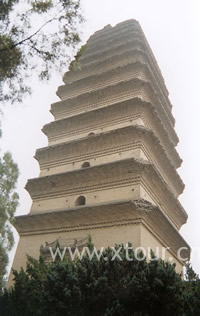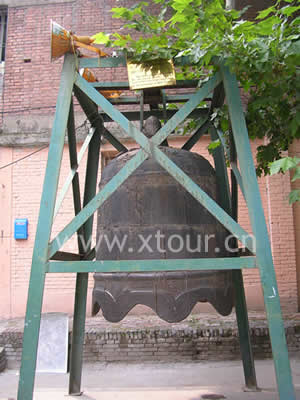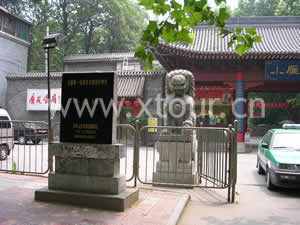 The Small Wild Goose Pagoda stands in Jian Fu Temple, one
kilometer south from the downtown area. If the Big Wild Goose
Pagoda can be compared to a stalwart young man, the Small Wild
Goose Pagoda is then like a delicate, slim girl. The Small Wild Goose Pagoda stands in Jian Fu Temple, one
kilometer south from the downtown area. If the Big Wild Goose
Pagoda can be compared to a stalwart young man, the Small Wild
Goose Pagoda is then like a delicate, slim girl.
Inside the Temple there is a huge iron bell dating from the Jin
Dynasty (1192 A. D. ). The Sound of the bell is crisp and pleasant,
and can be heard as far as five kilometers away. People here simply
call it the "Magic Bell". It's 4.5 metres in height, 7.6 in diameter
along the rim, and 10 tons in weight. It is carved with characters
that denote the following: Long live the Emperor; The vessals help
him forever; May the State be stable and the people live in peace;
May the Buddhist principles prevail in the time to come. In fact,
there is an interesting story about the Bell. It is said that if one
missed his beloved relations who are living far away from him, the
only thing he needs to do was to write their names and addresses on
a piece of yellow paper, and the sound of the bell would pass the
message to them. Hence, the "Morning Bell Chimes of the Pagoda"
became one of the eight famous scenic features in the province.
Jian Fu Temple was built in 684, in order to pay homage to the
Tang Emperor, Li Zhi, upon the hundred days of his death.
Therefore, it was originally named Xian Fu Temple. The present
name didn't come into being until 698 A. D.. The Temple was also
the place where the great translator Monk Yi Jing translated Bud-
dhist scriptures. Yi Jing set out by sea for India in search of Bud-
thist principles in 671. He came back with some four hundred volames,
for more than 20 years. On his way back to China, he stayed on Island of Sumatra in Indonesia and did some investigation there. Yi Jing translated altogether 56 volumes of scriptures in Jian Fu Temple and wrote the book Biography of Eminent Monks in the Tang Dynasty in Search of Buddhist Truth ih India. The book can be regarded as a companion to Pilgrimage to India by Xuan Zang, and is of great help to the study of Chinese and Indonesian history, as well as the history of the cultural relationship between China and Indonesia.
 The Small Wild Goose Pagoda was set up in 707. It has 15 storeys and is about 45 meters in height. The story goes that when Yi Jing appealed to the imperial court for funds to build a pagoda, so as to preserve the holy scriptures that he had brought back from India, the cowardly Emperor Li Xian asked the Queen's advice as he often did. When she heard of this, she ordered all the imperial concubines and court maids to donate money for the construction of the pagoda. The ladies were so generous in their donation, that there was still money left over even after the pagoda was finished. The Small Wild Goose Pagoda was set up in 707. It has 15 storeys and is about 45 meters in height. The story goes that when Yi Jing appealed to the imperial court for funds to build a pagoda, so as to preserve the holy scriptures that he had brought back from India, the cowardly Emperor Li Xian asked the Queen's advice as he often did. When she heard of this, she ordered all the imperial concubines and court maids to donate money for the construction of the pagoda. The ladies were so generous in their donation, that there was still money left over even after the pagoda was finished.
In the long history of its existence, there has even been a "magic healing" of the Pagoda! In 1487, there was an earthquake of 6 points on the Richter scale and a one-foot crack formed in the Pagoda from the top to the bottom. However, in 1521, 34 years after the. quake, there came another one! The crack healed overnight. This amazed the local people. Therefore they began to call it the "Magic Healing".
In September 1555, an official from the capital, named Wang He, stayed in the temple for a night on his way home. After he heard the story of the "Magic Healing" from a monk called Kan Guang who had personally witnessed the
incident, out of disbelief he engraved this story on the lintel of the
Pagoda's north gate. However, when repair work started after
1949, it was found that the healing was not "magic", but
"human". The early builders of the pagoda had made the founda-
tion into the shape of a hemisphere in accordance with the geo-
graphic nature of Xl'an. The foundation therefore evenly devided
the stress of the eartquakes. Thus, after enduring 70 quakes, the
pagoda still stands as firm as when it was first established. Looking
at this, we can only admire the marvelous workmanship of the an-
cient builders.
In 1555, there was another earthquake in Huaxian County of
this province. As a result the top two storeys of the pagoda were
destroyed and the present structure has only 13 storeys. In 1965,
the Government embarked on a repair program on the Small Wild
Goose Pagoda in the spirit of "returning the old to the original".
The body of the pagoda was enforced with steel and concrete. Ev-
ery brick, every piece of stone was checked or replaced. The stair-
case of the pagoda was also rebuilt. And a lightning rod was fixed
on top of the pagoda as well.
The Great Hall of the Buddha in the temple was built in the
Ming Dynasty. You might notice the strange assortment of colour
tiles on the roof of the Hall. Actually, there is a moving story about
this.
 During the reign of Emperor Ying Zong of the Ming Dynasty,
monk Shao Siji who was from a tribe in the western part of China,
came to be the abbot at the Jian Fu Temple. All of the original
buildings, except for the pagoda, inside the temple, had long been
destroyed, at the end of the Tang Dynasty. Monk Shao Siji
couldn't bear the Sight of such destruction and decay. He collected
all his savings and went out for donations for the repair of the Tem-
ple. However, he still did not have enough money. Thus, with
Shao Siji in the head, the monks went around picking up tiles still
usable from the ruins of the Tang Dynasty, and used them on the
Great Hall of the Buddha in the temple that was being repaired.
When the repair work was finished, Monk Shao wrote a report and
handed it to the Emperor through the Ministry of Rites, together
with a sketch of the temple for its royal naming. However,when
Emperor ~ing Zong saw from the sketch that the temple had green
glazed tiles on the roof, he burst into a rage. He ordered that Monk
Shao Siji and other monks be sentenced to death, and the whole
Jian Fu Temple be burnt to the ground. The reason for his anger
was that only the court itself could use glazed tiles. Using the same
tiles on the other structures was considered an act of infidelity to His
Majesty! It was only after some vassals' earnest admonition that the
Emperor reduced his order of death to an order that directed the
Ministry of Rites to investigate the cause for this whole matter.
When it was revealed through this investigation that the glazed
green tiles were from the ruins of the past dynasty and were over
hundreds of years old, the Emperor did "pardon" the monks by
withdrawing the death sentence on them. As a result, Jian Fri
Temple and its pagoda have remained till this day despite its green
tiles which were forbidden objects 'in the Ming Dynasty. During the reign of Emperor Ying Zong of the Ming Dynasty,
monk Shao Siji who was from a tribe in the western part of China,
came to be the abbot at the Jian Fu Temple. All of the original
buildings, except for the pagoda, inside the temple, had long been
destroyed, at the end of the Tang Dynasty. Monk Shao Siji
couldn't bear the Sight of such destruction and decay. He collected
all his savings and went out for donations for the repair of the Tem-
ple. However, he still did not have enough money. Thus, with
Shao Siji in the head, the monks went around picking up tiles still
usable from the ruins of the Tang Dynasty, and used them on the
Great Hall of the Buddha in the temple that was being repaired.
When the repair work was finished, Monk Shao wrote a report and
handed it to the Emperor through the Ministry of Rites, together
with a sketch of the temple for its royal naming. However,when
Emperor ~ing Zong saw from the sketch that the temple had green
glazed tiles on the roof, he burst into a rage. He ordered that Monk
Shao Siji and other monks be sentenced to death, and the whole
Jian Fu Temple be burnt to the ground. The reason for his anger
was that only the court itself could use glazed tiles. Using the same
tiles on the other structures was considered an act of infidelity to His
Majesty! It was only after some vassals' earnest admonition that the
Emperor reduced his order of death to an order that directed the
Ministry of Rites to investigate the cause for this whole matter.
When it was revealed through this investigation that the glazed
green tiles were from the ruins of the past dynasty and were over
hundreds of years old, the Emperor did "pardon" the monks by
withdrawing the death sentence on them. As a result, Jian Fri
Temple and its pagoda have remained till this day despite its green
tiles which were forbidden objects 'in the Ming Dynasty.
Transport : Bus 18 21 29 29qujian 32 40 46 203 204 224 401zhuanxian 407 508 521 610 700 707 713 720 722 travel7
;
Opening time : Daily 9am to 5pm;
Admission : 18 tower 10 |

